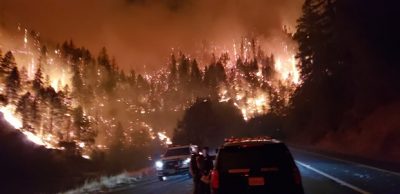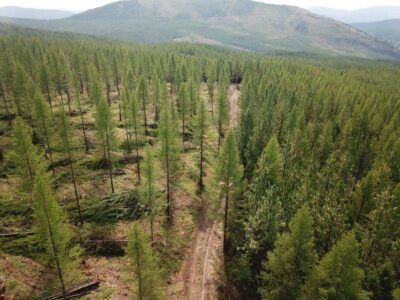Wildfires, CEQA, Climate Change & the Courts
Recent Court Decisions Halt Building Projects, Invalidate CEQA Reviews for Failing to Assess Wildfire Hazards
 Environmental and conservation groups have for a number of years attempted to convince California courts of the need to integrate climate change considerations into environmental analyses prepared under the state’s most important environmental law, the California Environmental Quality Act (CEQA). However, the California judiciary has demonstrated little appetite for doing so. Until now.
Environmental and conservation groups have for a number of years attempted to convince California courts of the need to integrate climate change considerations into environmental analyses prepared under the state’s most important environmental law, the California Environmental Quality Act (CEQA). However, the California judiciary has demonstrated little appetite for doing so. Until now.
Recently, courts at either end of the state issued remarkably similar rulings invalidating environmental impact reports two California counties prepared under CEQA in connection with large development projects. As a result, those projects are currently on hold.
Both of these cases were filed by the Center for Biological Diversity (CBD). Both drew the attention of the California Attorney General’s Office, which intervened in both lawsuits, aligning itself with CBD to argue successfully that the CEQA analyses for both projects were legally inadequate.
For residents of California and much of the American West, the single most alarming manifestation of climate change is the frequency, size and intensity of wildfires that have ravaged the region in recent years. It is the increased risk to public health, safety and the environment posed by wildfires that is at the heart of the new court decisions.
As reported in the Sacramento Bee, the proposed Guenoc Valley Resort is a $1 billion luxury housing and resort project proposed for a rural portion of Lake County, near the Napa County border. The project encompasses 16,000 acres and would bring over 4000 people to a currently sparsely populated area. Notably, a substantial portion of the project site burned in a 2020 wildfire.
CBD and other environmental groups oppose new housing and business projects in remote areas posing extreme wildfire risks. That’s a legitimate concern: the Sacramento Bee article notes that as many as 1.2 million new homes are projected to be built in California between 2000-2050 in what the California Department of Forestry & Fire Protection (CalFire) classifies as the state’s highest wildfire risk areas. And as Lake County Superior Court Judge J. David Markham noted in his decision in the Guenoc Valley Resort case, “a significant number of wildfire-related deaths occur during attempts to evacuate” during wildfires. Indeed, in the 2018 Camp Fire–the worst in California’s history–at least eight people burned to death in their cars while trying to escape from their homes, stuck in evacuation traffic on clogged country roads.
That was the key CEQA issue in the CBD v. County of Lake case: whether analysis of public safety risk and community evacuation plans is required under CEQA, and if the Guenoc project would exacerbate existing environmental hazards. CBD and California Attorney General Rob Bonta asserted that the answer to both questions was yes, and Judge Markham agreed. As Markham wrote in his lengthy decision, the project EIR “does not focus on the issue that is required to be addressed by CEQA: whether evacuation of the residents in the nearby area would be affected by evacuation of the project’s residents during a wildfire.” The judge observed:
[People drawn to the area by the Guenoc project] “will likely compete with residents in the surrounding area for safe evacuation routes. The additional people competing for the same limited routes can cause congestion and delay in evacuation, resulting in increased wildfire related deaths. This is undoubtedly a situation where the Project, by bringing a significant number of people into the area, may significantly exacerbate existing environmental hazards; specifically, wildfires and their associated risks.”
Attorney General Bonta commented on the Lake County ruling:
“This is a win for Lake County residents who can rest easier knowing that this project will only move forward if the developer takes proactive steps to ensure their safe evacuation if and when a wildfire occurs.”
Meanwhile, a quite similar CEQA lawsuit played out in San Diego County recently. There, a developer proposed building the Otay Ranch project on 23,000 acres in an unincorporated, rural area–the largest development project in county history. The planned development includes nearly 2000 new residential units, a resort, and commercial and office space. Together, the project is projected to bring 7850 new permanent residents and guests to the area on a daily basis.
CalFire has designated the area in which the Otay Ranch project is proposed as a “very high fire hazard severity zone”–CalFire’s most dangerous classification. And with good reason: the project site was completely burned in the 2003 Mine Otay fire, and the majority of the site burned again in a 2007 wildfire.
CBD filed a CEQA lawsuit against San Diego County and the Otay Ranch developer, making the same arguments on which it prevailed in the Lake County case. Again, the California Attorney General intervened on CBD’s behalf. Late last year, the San Diego Superior Court ruled, consistent with the Lake County Superior Court, that the Otay Ranch EIR was legally deficient for its failure to assess the increase in wildfire danger and public safety posed by the Otay Ranch project.
(In a related development, opponents of the massive Tejon Ranch Centennial Project, which proposed 19,300 new homes be built in a rural portion of northern Los Angeles County, successfully advanced the same CEQA/wildfire/public safety argument before the Los Angeles County Superior Court. After the judge ruled in their favor, that case quickly settled.)
These recent decisions in Lake County, San Diego County and L.A. County reflect an important CEQA trend. They represent the first time California courts have acknowledged that at least one key consequence of climate change–the increased frequency and intensity of wildfires–warrants analysis under CEQA.
To be sure, opposition to large development projects in rural areas is offset by California’s acknowledged housing crisis and the need to expand dramatically the amount of statewide housing stock. But it’s profoundly poor public policy to site major housing projects in remote, wildfire-prone areas with minimal road infrastructure and inadequate evacuation routes. A far safer and environmentally-superior housing strategy is to concentrate new housing developments in existing urban areas of the state.
Finally, two wildfire-related postscripts: first, a coalition of news organizations published a 2019 study concluding that only 22% of communities in California’s most fire-prone areas currently have adequate, publicly-available evacuation plans. That’s an alarming statistic.
Second, California Insurance Commissioner Richard Lara recently suggested that the State of California should discourage new development in fire-prone areas by withholding state funds for infrastructure “where risk from climate disasters is too high.” That is an excellent proposal.








Reader Comments